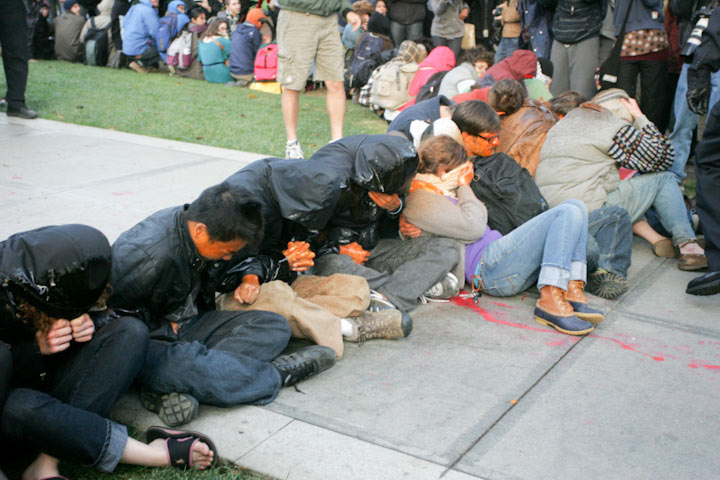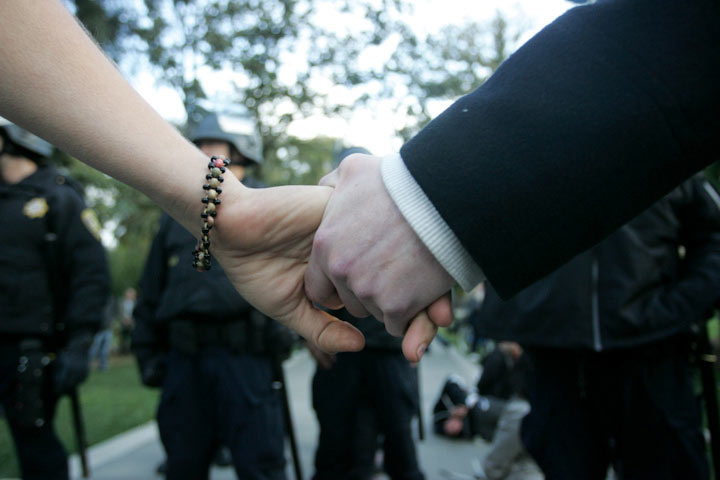Interview with a pepper-sprayed UC Davis student:

Photo: Bryan Nguyen/The Aggie.
22-year-old UC Davis student W. (name withheld by request) was one of the students pepper-sprayed at point-blank range Friday by Lt. John Pike while seated on the ground, arms linked and silent.
W. tells Boing Boing that Pike sprayed them at close range with military-grade pepper spray, in a punitive manner. Pike knew the students by name from Thursday night when they "occupied" a campus plaza. The students offered Pike food and coffee and chatted with him and other officers while setting up tents. On Friday, UC Davis chancellor Linda Katehi told students they had to remove their #OWS tents for unspecified "health and safety" reasons.
"Move or we're going to shoot you," Pike is reported to have yelled at one student right before delivering pepper spray. Then, turning to his fellow officers and brandishing the can in the air, "Don't worry, I'm going to spray these kids down."

Photo: Bryan Nguyen/The Aggie.
XJ: So, we see in the videos and photos that you were one of the students pepper-sprayed by Lieutenant John Pike yesterday. How are you doing today?
W: I still have a burning sensation in my throat, lips and nose, especially when I start coughing, or when I'm lying in bed. Everyone who got sprayed has sustained effects like this.
XJ: Can you tell us how it happened, from where you were sitting?
W: I'd pulled my beanie hat over my eyes, to protect my eyes. I received a lot of pepper spray in my throat. I vomited twice, right away, then spent the next hour or two dry heaving. Someone said they saw him spray down my throat intentionally, but I was so freaked out, and I was blinded by my hat, so I can't verify. I did get a large quantity of pepper spray in my lungs.
Another girl near me who has asthma had an attack triggered by the pepper spray, and she was taken to the hospital.

Photo: Bryan Nguyen/The Aggie.
He used military grade pepper spray on us. It's supposed to be used at a minimum of 15 feet. But he sprayed us at point blank range. Another student, 20 years old, who was sprayed and then arrested—instead of receiving medical care for the pepper spray exposure, he was made to wait in the back of a police car. His hands were sprayed, and he had intense burning in his hands throughout the evening while he was being held. He asked a police officer what they could do to stop it, and they refused to give any advice.

Photo: Bryan Nguyen/The Aggie.
XJ: Take us back to what led up to that moment. Friday's protest wasn't an isolated expression, or the beginning of the Occupy Wall Street movement on the university campus, right?
W: We'd been protesting at UC Davis for the last week. On Tuesday there was a rally organized by some faculty members in response to the brutality on the UC Berkeley campus, and in response to the proposed 81% tuition hike.
One of the reasons I am involved with #OWS, and advocating for an occupy movement on the UC campus, is to fight privatization and austerity in the UC system, and fight rising tuition costs. I think that citizens have the right to get an education regardless of economic condition. Most people are not going to get a job where they can afford to pay off student loans. But to exclude people from knowledge is unconscionable.
The #OWS movement is global, but it's expressed locally in ways that are relevant to each city. People who are in NYC go to Wall Street. Oakland takes the port. At Davis, we have a university.

Photo: Bryan Nguyen/The Aggie.
So the Tuesday protest was one of the biggest rallies on the campus since tuition hikes in 2009. That protest ended with a march around the campus, which led us to the administrative building. Sort of spontaneously, we all decided to occupy an area on the grounds and we stayed the night. The administration allowed it.
I had a wonderful conversation with Lieutenant Pike that night. I dialogued with him for a while. He was cordial to me. He knew me by name. We offered him coffee and food.
We have a food collective, and we are organizing to feed the occupiers with food we grow at the student farm. It was all really lovely.
On Wednesday there was the big protest in San Francisco, and striking at the UC regents meeting
over the proposed 81% tuition increase next year. The regents actually canceled their meeting because they knew we were coming, and they have since decided to do it by teleconference next Monday so we can't disrupt them.
UC Davis police cleared out the 15 or so protesters who remained in Mrak Hall while the rest of the occupiers had left for the demonstration in San Francisco.
We had another rally on Thursday, with a big General Assembly. We decided to have an occupation against the injustices we were facing, and on Thursday night there were 35 tents set up, with more planning on coming.

Photo: Bryan Nguyen/The Aggie.
It was beautiful. We we had food, we sang songs, students were tutoring other students. We were talking about important issues, dialoguing over issues affecting our campus.
Chancellor Katehi agreed to let us waive the "no camping on campus" policy that night, and allowed us to stay there.
That same night, we went to the associated students of UC Davis student government meeting on campus, and we asked them for a resolution for peaceful protest without police intervention. We wrote it, they passed it, and we now had the support of the student body to have this protest, which was great.
The next morning we woke up, made breakfast, and had a lovely morning.
Pretty early on, before noon we got a letter from chancellor Katehi to please remove our tents, citing health and safety reasons, but not saying what those reasons are.
We took the letter, and replied more or less: look, we understand we're in violation of the camping code. But we believe that this is superseded by our first amendment rights.

Photo: Bryan Nguyen/The Aggie.
On Friday, they delivered another letter: at 3pm your tents will be taken down. This letter was not signed, it was just one paragraph in a big ugly font. Not on letterhead.
"We are demanding you remove these tents by 3pm," it read, "You need to move to another area on the campus so we can remove these tents, and if you do not comply you will be arrested."
We talked amongst ourselves, and decided that we were going to stay. We spent the next few hours talking about tactics so our tents wouldn't get stolen. Maybe we'd go to the Occupy City of Davis camp, and just keep migrating so they couldn't take us down.
And then, at around 330pm Friday, riot police. A lot of them showed up. We saw them and put our tents in the middle of the area. We'd been keeping the paths clear
keeping space immaculately clean, feeding everyone who was hungry who came by... we tried to talk to the campus groundskeepers and tell them that we understood they need to do their job. We offered to move our tents so they could water the lawn. We wanted not to disrupt unnecessarily.

Photo: Bryan Nguyen/The Aggie.
When the riot police came, we put our tents in a circle. We walked around in a circle, and said nothing hateful towards the police. Maybe one guy chanted, "Fuck the police" a few times, but it died down right away. None of us wanted to chant against the police.
And then the police officers rushed in.
We were chanting so loud we couldn't hear any order to disperse. And with no warning, moving incredibly violently, they seized a few students.

Photo: Bryan Nguyen/The Aggie.
They handcuffed the students so tightly. One kid, later on they were unable to cut off his ties, they'd been tied so tight. One of the other students couldn't feel his hands they were so purple, his circulation was cut off so badly for so long. He took himself to the hospital after he was released from the zip-tie restraints. They told him he had nerve damage and not to expect to be able to feel his hands for the next week. He has to come back next week to see if there was permanent nerve damage in his wrists.
We came back to the area after that round of arrests. That's when the recording for most of the video you see on the internet was started.
We yelled, "clear these tents," we didn't want them to take our tents. Aside from refusing the order to disperse, the only rule we were breaking was camping on campus. But since we had the first night waived by Chancellor Katehi, we really
hadn't even broken university policy, she waived the code.

Photo: Bryan Nguyen/The Aggie.
So, everyone removed the tents, and they were in the process of arresting more people. A collective decision was made on the fly to just sit in a circle arms linked legs crossed, with police officers and "prisoners" in the middle because we didn't want them arresting only 3 of us. It wasn't fair that 50 of us were there, and only a few arrested who hadn't volunteered to be arrested.
There was still one walkway open that the police were going to use to walk the arrestees out. I saw some friends of mine sit down there, and they were my friends, so I joined them. We linked arms, legs crossed.

Photo: Bryan Nguyen/The Aggie.
We were never warned that we were going to be pepper-sprayed.
Lt. Pike walked up to my friend, and I am told that he said, "Move or we're going to shoot you."
Then he went back and talked to a few of his police officer friends.
A couple of other officers started to remove people who were sitting there, blocking exit. Pike could have easily removed us, just picked us up and removed us. We were just sitting there, nonviolent civil disobedience.
But Pike turned around and I am told that he said to the other officers, "Don't worry about it, I'm going to spray these kids down."
He lifts the can, spins it around in a circle to show it off to everybody.
Then he sprays us three times.
As if one time of being sprayed at point blank wasn't enough.
I was on the end of the line getting direct spray. When the second pass came, I got up crawling. I crawled away and vomited on a tree. I was yelling. It burned. Within a few minutes I was dry heaving, I couldn't breathe. Then, over the course of the next hour, I was dry heaving and vomiting.

Photo: Bryan Nguyen/The Aggie.
More people were arrested, then. One other person told me he was pepper sprayed while he was on the ground subdued.
They tried to go up his shirt, because he'd pulled his shirt over his face to protect himself. So they aimed it up his shirt to spray him, to make sure he got it.
XJ: Chancellor Katehi finally gave a press conference tonight about that incident.
W: I was the first one there. I went right up to her and introduced myself. "I'm an undergrad here. I'm a victim of police brutality," I told her. "The police sprayed pepper spray down my throat. I do not feel you have done your job protecting me on your campus. I hold you personally responsible for inflicting pain on me."

Photo: Bryan Nguyen/The Aggie.
XJ: What do you want from Katehi, and the UC system?
W: I can't speak on behalf of the movement, I can only speak on behalf of myself. But I personally request that Chancellor Katehi and Lt. John Pike resign. We have a petition out there already. I request that a mechanism be set up for the impeachment of chancellors, and a system for democratic election of our chancellors. There is no good reason why students and faculty don't make that decision.
Even when a chancellor makes a decision likes this, they feel safe, because they've been appointed by the regents, and the goal of the regents is to make more money.
They sit on the boards of big institutions like Bank of America, they are the richest of the 1%, and they're using this institution to fatten their pockets
and they're putting students into debt to do that.
There will be a large rally on Monday at UC Davis, and I invited her to take part in our GA, if she's willing to speak to us on our terms and operate on consensus method with no power dynamics.
She made a promise right there, on video, to come to our meeting.
I think she has done a terrible misdeed and that she and Pike should resign immediately so we can figure out a better way to run this institution.

Photo: Bryan Nguyen/The Aggie.

Photo: Bryan Nguyen/The Aggie.






























